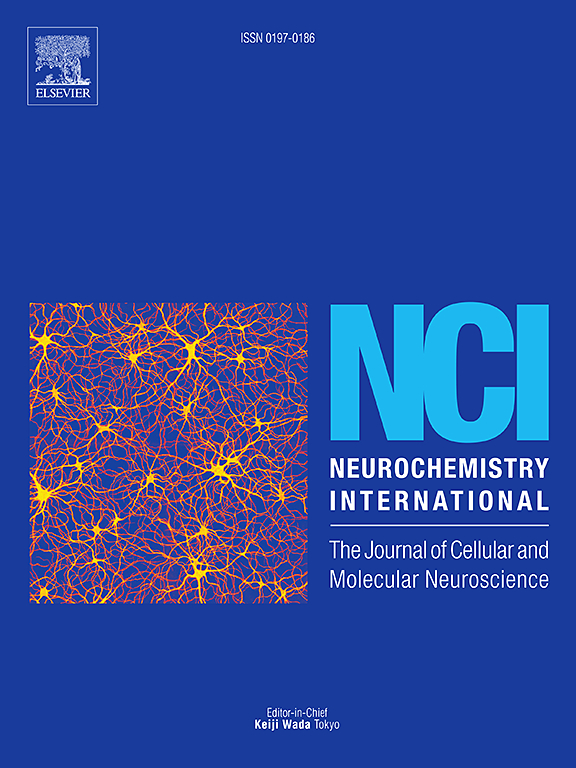阿片类药物通过促进结肠肌丛α -突触核蛋白过度磷酸化诱导便秘
IF 4
3区 医学
Q2 BIOCHEMISTRY & MOLECULAR BIOLOGY
引用次数: 0
摘要
阿片类药物引起的便秘(OIC)是与阿片类药物使用相关的最常见的胃肠道疾病。它与神经递质释放受损有关。α-突触核蛋白(α-Syn)在神经系统中维持神经递质稳态和调节突触可塑性方面起着至关重要的作用。然而,它在疾病进展中的作用仍不清楚。本研究采用Sprague-Dawley大鼠OIC模型,研究α-Syn过磷酸化对结肠运动障碍和便秘症状的影响。我们的结果表明,Ser129磷酸化位点(pS129-α-Syn)的α-Syn在OIC大鼠结肠肌肠层的表达显著增加。相反,抑制pS129-α-Syn逆转结肠运动障碍,增加突触功能蛋白Synapsin-1、Synaptotagmin-1、囊泡相关膜蛋白2 (VAMP-2)和Syntaxin-1的表达,以及肠内神经递质合成酶,包括神经元一氧化氮合成酶(nNOS)和三磷酸腺苷合成酶(ATPB)的表达。此外,我们发现阿片通过激活μ-阿片受体(MOR)下调Ser9位点GSK3β蛋白的表达。这增加了GSK3β激酶活性,最终诱导pS129-α-Syn过表达。综上所述,OIC的发生与结肠肌丛神经元α-Syn过磷酸化有关。阿片类药物可通过GSK3β/α-Syn过磷酸化信号轴抑制突触囊泡运输和肠内神经递质释放,最终导致结肠运动障碍和便秘。本文章由计算机程序翻译,如有差异,请以英文原文为准。
Opioids induce constipation by prompting alpha-Synuclein hyperphosphorylation in the colonic myenteric plexus
Opioid-induced constipation (OIC) is the most common gastrointestinal disorder associated with opioid use. It is linked to impaired neurotransmitter release. Alpha-Synuclein (α-Syn) plays a crucial role in maintaining neurotransmitter homeostasis and regulating synaptic plasticity in the nervous system. However, its role in the disease progression remains unclear. In the present study, we investigated the impact of α-Syn hyperphosphorylation on colonic dysmotility and constipation symptoms using a Sprague-Dawley rat model of OIC. Our results suggest that α-Syn expression at the Ser129 phosphorylation site (pS129-α-Syn) is significantly increased in the colonic myenteric layer of OIC rats. Conversely, inhibiting pS129-α-Syn reversed the colonic dysmotility and increased the expression of synaptic functional proteins, such as Synapsin-1, Synaptotagmin-1, vesicle-associated membrane protein 2 (VAMP-2), and Syntaxin-1, as well as enteric neurotransmitter synthases, including neuronal nitric oxide synthase (nNOS) and adenosine triphosphate synthase (ATPB). Additionally, we found that opioids downregulate GSK3β protein expression at the Ser9 site by activating the μ-opioid receptors (MOR). This increases GSK3β kinase activity, ultimately inducing pS129-α-Syn overexpression. In summary, the development of OIC correlates with α-Syn hyperphosphorylation in myenteric plexus neurons in the colon. Opioids can inhibit synaptic vesicle trafficking and enteric neurotransmitter release via the GSK3β/α-Syn hyperphosphorylation signaling axis, ultimately leading to colonic dysmotility and constipation.
求助全文
通过发布文献求助,成功后即可免费获取论文全文。
去求助
来源期刊

Neurochemistry international
医学-神经科学
CiteScore
8.40
自引率
2.40%
发文量
128
审稿时长
37 days
期刊介绍:
Neurochemistry International is devoted to the rapid publication of outstanding original articles and timely reviews in neurochemistry. Manuscripts on a broad range of topics will be considered, including molecular and cellular neurochemistry, neuropharmacology and genetic aspects of CNS function, neuroimmunology, metabolism as well as the neurochemistry of neurological and psychiatric disorders of the CNS.
 求助内容:
求助内容: 应助结果提醒方式:
应助结果提醒方式:


